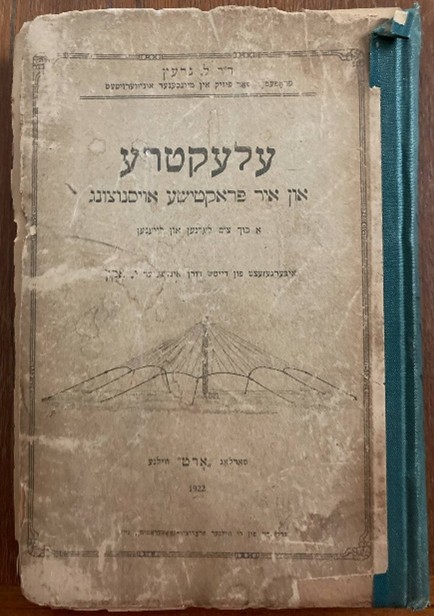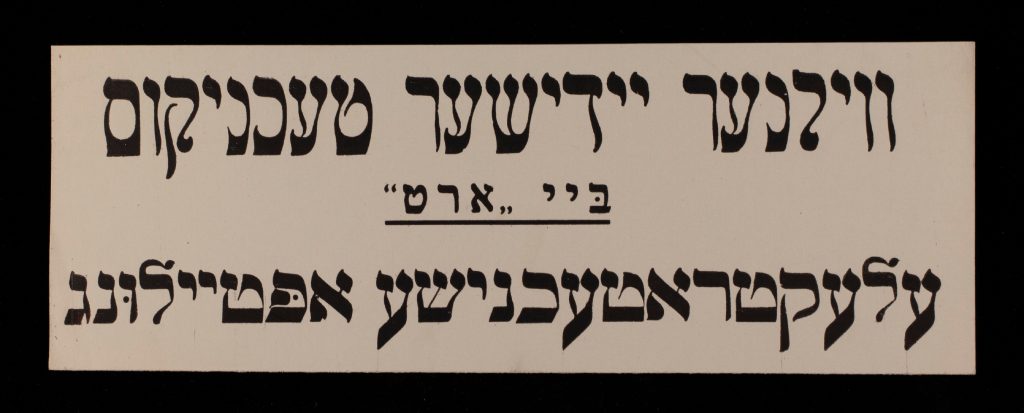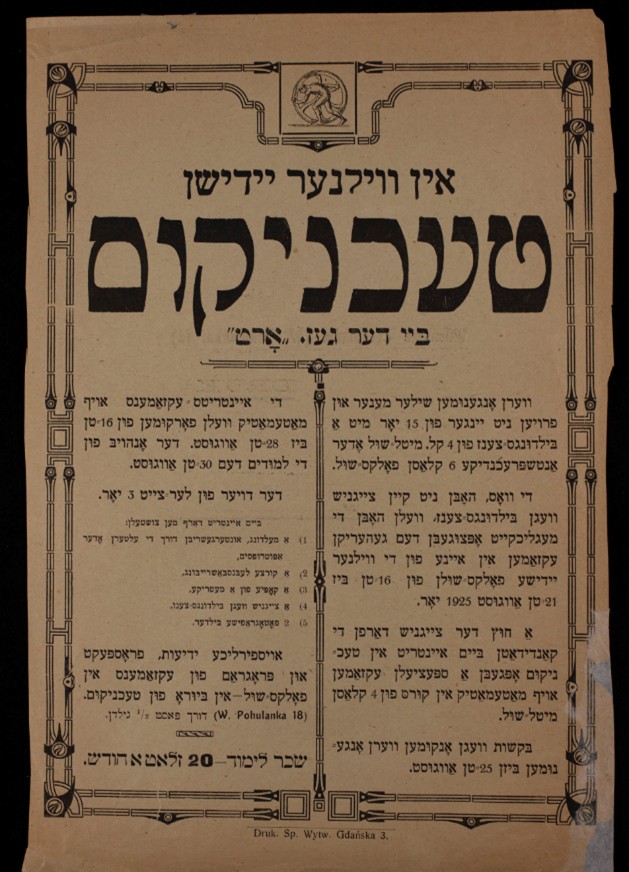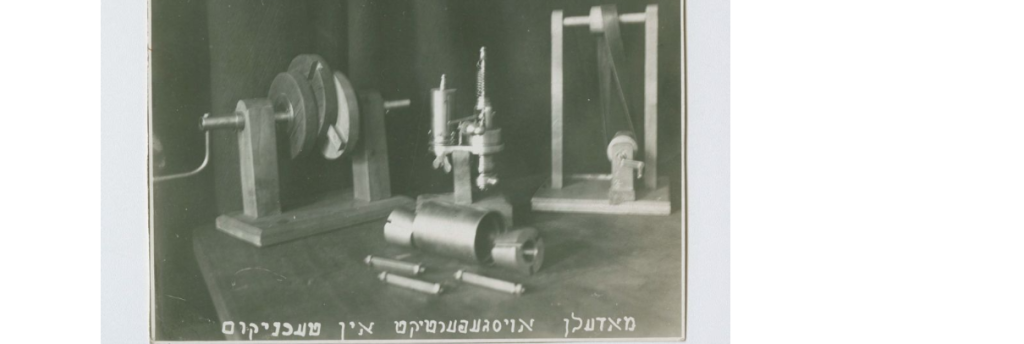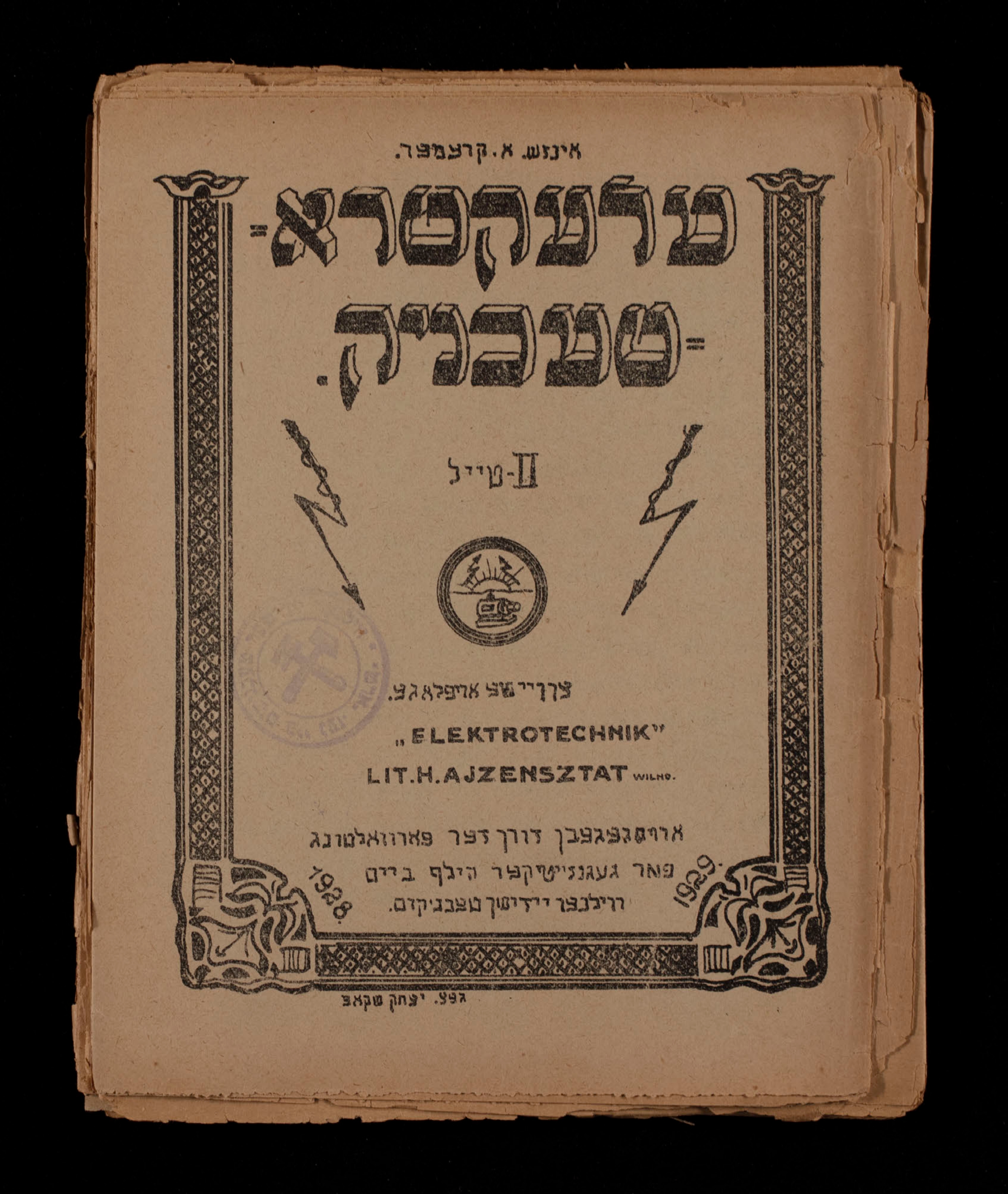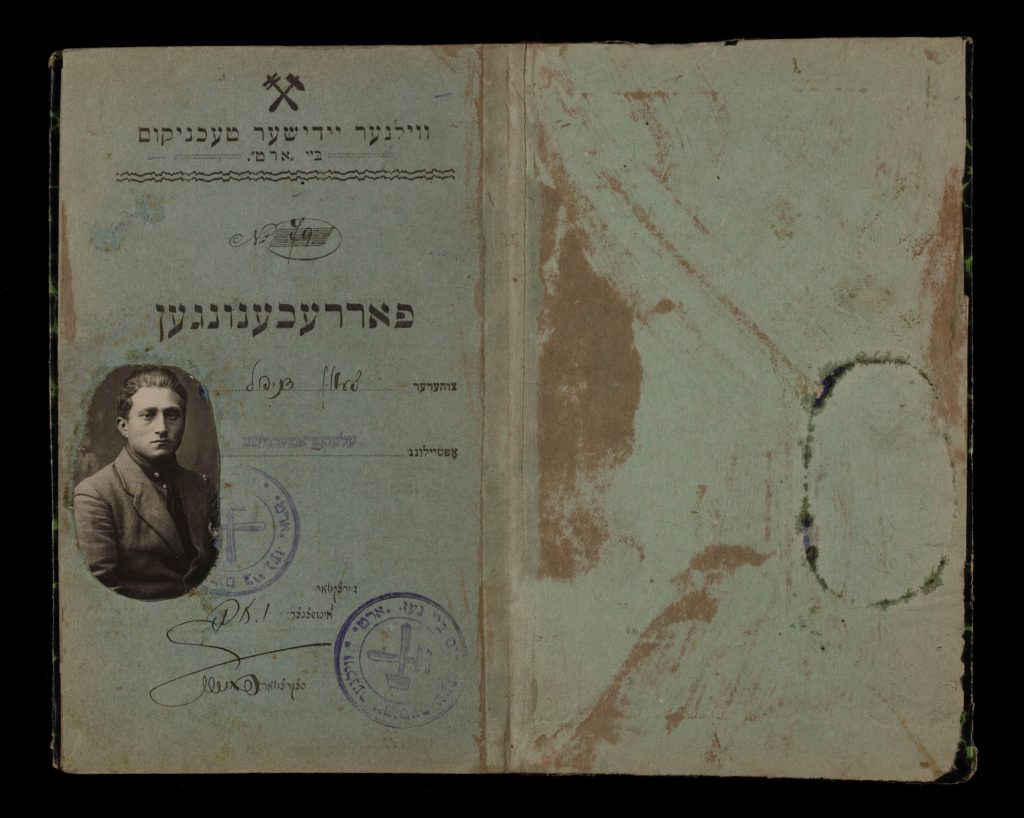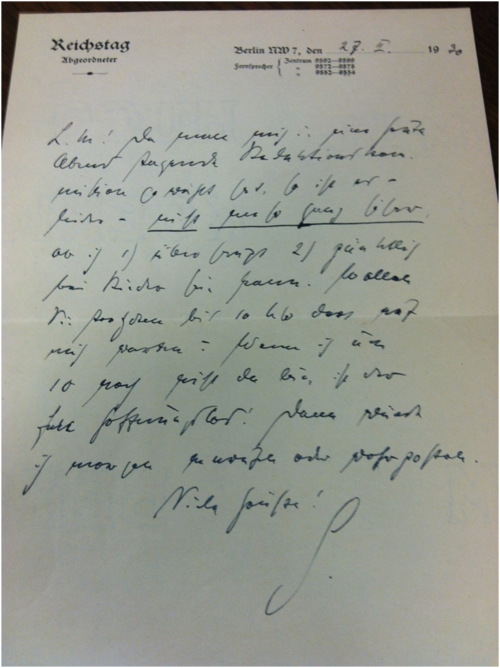By Alona Bach, Dr. Sophie Bookhalter Short-Term Graduate Public History Fellow
Electrical Engineering in Yiddish: The Vilna Technicum (and Beyond)
“Up to this point, there has not been a single book about electricity in Yiddish, aside from a few small pamphlets,” declared the engineer Israel Okun in January 1922. It was a bold, frank introduction to his new Yiddish translation of a German textbook about electricity.
Photograph of Israel Okun, first director of the Technicum in Vilna. Letter O, General. Bund Photographs. RG 1402. Drawer C-28-2, Folder 173. Collection of YIVO Archives.
Writing from Vilna (Vilnius), Okun argued that “a marked need for such [Yiddish] books has long made itself felt. Electricity is infiltrating more and more cities and towns where wide swathes of Jewish social strata can be found”—Vilna’s first central power station had powered the city’s streetlights since 1903—“and the number of Jewish electrical engineers [elektrotekhniker] and electricians [elektromontiori] is growing. […] Yiddish technical courses are being opened in schools, people enroll in Yiddish lectures on the subject of electrical engineering—and yet the necessary books in Yiddish, which would offer a systematic explanation of electricity, are lacking.”
Okun’s Yiddish translation of Electricity and Its Practical Applications (Elektre un ir praktishe oysnitsung) was poised to meet that need. The 270-page textbook began with an introduction to electromagnetism and the production of electric current (Chapters 1-3); and later covered topics including batteries (Chapter 4); induction and dynamos (Chapter 5); power stations, high tension wires, transformers, electric trams, and electric trains (Chapter 6); incandescent bulbs with carbon and metal filaments (Chapter 7); and cathode rays, fluorescence, and Moseley’s Law (Chapter 9).
 Elektre un ir praktishe oysnutsung: a bukh tsum lernen un leyenen, trans. Israel Okun [from Leo Graetz, Elektrizität und ihre Anwendungen, 11th ed.] (Vilne: Farlag ORT, 1922).
Elektre un ir praktishe oysnutsung: a bukh tsum lernen un leyenen, trans. Israel Okun [from Leo Graetz, Elektrizität und ihre Anwendungen, 11th ed.] (Vilne: Farlag ORT, 1922).
In 1922, Okun’s desire for pedagogical materials was both pragmatic and pressing. He had just begun his term as the first director of Vilna’s newly-established Jewish Vocational (Technical) School of ORT, known sometimes as the Technicum, which he had helped found the year before. The Technicum offered Jewish teenagers a three-year curriculum in either mechanics or electrical engineering—proof, its founders hoped, “that, in Yiddish, one could teach not only mathematics, but also specialized technical studies.” Each year, between one- to two-hundred students enrolled in Technicum courses. And to teach these students, the Technicum needed textbooks.
A placard reading “Vilner yidisher Technicum bay ORT: Electrical Engineering Department.” Photograph; miscellaneous placards, undated, Records of the ORT Vocational School (Technicum) in Vilna, RG 21, Box: 6, Folder: 93. Collection of YIVO Archives.
Flyers advertising admissions requirements for the Technicum. In 1923 (below left), students needed to be older than 16 to apply; a later advertisement (below right, c. 1926-1933) invites “men and women no younger than 15” to apply for the Technicum. Students that year would enroll in a course of six semesters at 20 zloty a month, to begin August 30.
Announcement of Mechanical High School/Lyceum admission requirements and entrance examinations, 1939. Records of the ORT Vocational School (Technicum) in Vilna RG 21, Box: 6, Folder: 92A. Collection of YIVO Archives.
“Models built in the Vilna ORT Technicum, 1935.” ORT Photograph Collection, RG 380. Collection of YIVO Archives.
Okun’s translation may have been the first electrical engineering textbook made with Technicum students in mind, but it wasn’t the last. Just five years later, the prominent Marxist and “Father of the Bund” Arkadi (Aron) Kremer (1865-1935) handwrote a series of textbooks specially for the Technicum’s curriculum. (Kremer, an instructor at both the Technicum and the Vilna Teacher Seminar, also had strong engineering bonafides: he had studied at the Technological Institute in Saint Petersburg before his first arrest for revolutionary activities.) Kremer’s 1927 textbook guided students through the first five terms of the Technicum’s electrical engineering curriculum, and was distributed in lithographed copies to keep costs low for students. The copy of Part I held and digitized by the CJH includes a 1930 inscription from Technicum director Mateusz (Matisyahu) Szrejber to “the great thinker and fighter for new forms of Jewish life, the friend of ORT,” the famed diaspora nationalist Chaim Zhitlowsky.
Kremer, Arkady and Kremer, Pati. Bund Photographs, RG 1402, Drawer C 28-1, Folder 116 Item 52. Collection of YIVO Archives.
Right: Textbook – “Elektrotekhnik” (Electrical Engineering), by A. Kremer, 1st half year, 1927. Records of the ORT Vocational School (Technicum) in Vilna, RG 21, Box: 7, Folder: 111, p. 10. Collection of YIVO Archives.
Left: The cover of the 1928-1929 edition of “Elektrotekhnik” (Electrical Engineering), by A. Kremer, Part II, 2nd edition Issued by the “Farvaltung far gegnzaytiker hilf” (Administration for Mutual Aid) of the Technicum; cover illustrations by Yitskhok Shkop (Szkop). Records of the ORT Vocational School (Technicum) in Vilna, RG 21, (Box 7, Folder 113). Collection of YIVO Archives.
Leon Daniel (above), a student in the Technicum’s Electrical Engineering Department, took his first-year Electrical Engineering course with Kremer in 1922—alongside Algebra I, Geometry I, Physics I, Technical Drafting I, Theoretical Mechanics I, practical laboratory work, and other courses. His course record booklet has been signed by the Technicum’s then-director, Israel Okun (below).
Student identification cards and booklets recording course credits. Records of the ORT Vocational School (Technicum) in Vilna, RG 21, Box 6, Folder 85. Collection of YIVO Archives.
By the end of the interwar period, Yiddish readers in Eastern Europe could learn about electricity from a range of popular and technical Yiddish-language texts (many in translation, and many from the Soviet Union). These ranged from the academic A Simple Explanation of Dynamos, Motors, and Transformers; Direct and Alternating Current; Guidebook for Technicums and Institutions of Higher Education (Minsk: Oysgabe fun Vaysrusishn melukhe-universitet, 1929) and The Practical Electrical Engineer (Bialystok: 1925), to the accessible 63-page Advice for a Young Electrical Engineer, Inventor (Kharkiv: Ukrmelukhe natsmindfarlag, 1932), What is Electricity? (Warsaw: Kultur-lige, 1929), Electricity at Home: Lighting, Telegraph, Telephone, Radio (Kyiv: Kultur-lige, 1930), and even a pamphlet featuring electrical experiments for children (Moscow: Farlag ‘Emes’, 1932). At the Technicum itself, instructor and engineer M. Gordon had written two more textbooks for students, focused on electric grids and power stations, respectively. But the era of Vilna’s Yiddish-language Technicum was over almost as soon as it began: the school was forced to close after the Soviet occupation of Vilna in 1940, not two full decades after it had first opened its doors to aspiring engineers.
Learn more about the Technicum by exploring YIVO’s digitized collections.
ORT workshop in Vilna, [c.1920s-1930s]. ORT Photograph Collection. RG 380, Box C15, Drawer 2, Folder 1277. Collection of YIVO Archives.
Thank you to YIVO archivist Jessica Podhorcer for generous research assistance and guidance on this project.


